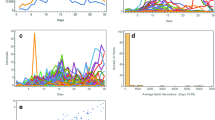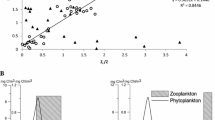Summary
The use of parameter estimation techniques for partial differential equations is illustrated using a predatorprey model. Whereas ecologists have often estimated parameters in models, they have not previously been able to do so for models that describe interactions in heterogeneous environments. The techniques we describe for partial differential equations will be generally useful for models of interacting species in spatially complex environments and for models that include the movement of organisms. We demonstrate our methods using field data from a ladybird beetle (Coccinella septempunctata) and aphid (Uroleucon nigrotuberculatum) interaction. Our parameter estimation algorithms can be employed to identify models that explain better than 80% of the observed variance in aphid and ladybird densities. Such parameter estimation techniques can bridge the gap between detail-rich experimental studies and abstract mathematical models. By relating the particular bestfit models identified from our experimental data to other information on Coccinella behavior, we conclude that a term describing local taxis of ladybirds towards prey (aphids in this case) is needed in the model.
Similar content being viewed by others
References
Banks HT (1981) Parameter identification techniques for physiological control systems. In: Lectures in Applied Math. Hoppensteadt F (ed) Am Math Soc, Providence, RI, 19:361–383
Banks HT (1985) On a variational approach to some parameter estimation problems. In: Distributed Parameter Systems. Springer Lec. Notes in Control & Info. Sci. 75:1–23
Banks HT, Kereiva P (1983) Parameter estimation techniques for transport equations with applications to population dispersal and tissue bulk flow models. J Math Biol 17:253–273
Banks HT, Murphy KA (1986) Quantitative modeling of growth and dispersal in population models. LCDS Report no 86-4, Brown University, and Proc International Sympl on Math Biol, Kyoto, Nov. 10–15, 1985, Springer LN in Biomath 71:98–109
Bank HT, Murphy KA (1987) Estimation of nonlinearities in parabolic models for growth, predation and dispersal of populations. LCDS/CCS Report No. 87-36, Brown University
Banks HT, Crowley JM, Kunisch K (1983) Cubic spline approximation techniques for parameter estimation in distributed systems. IEEE Trans Auto Control AC-28:773–786
Banks HT, Kareiva PM, Lamm PK (1985) Modeling insect dispersal and estimating parameters when mark-release techniques may cause initial disturbances. J Math Biol 22:259–277
Belovsky G (1984) Moose and snowshoe hare competition and a mechanistic explanation of foraging theory. Oecologia (Berlin) 61:150–159
Chesson PL, Case TJ (1985) Nonequilibrium community theories: chance, variability, history and coexistence. In: Community Ecology. Diamond J, Case T (eds) Harper & Row, NY, pp 229–239
Kareiva P (1985) Patchiness, dispersal, and species interactions: consequences for communities of herbivorous insects. In: Community Ecology. Diamond J, Case T (eds) Harper and Row, NY, pp 192–206
Kareiva P (1986) Trivial movement and foraging by crop colonizers. In: Ecological Theory and Pest Management. Kogan M (ed) Wiley-Interscience, NY, pp 99–122
Kareiva P, Odell G (1987) Predator aggregation and the containment of prey outbreaks as a result of area restricted search behavior. Am Nat (in press)
Levin S (1974) Dispersion and population interactions. Am Nat 108:207–228
Mueller LD, Ayala FJ (1981) Dynamics of single-species population growth: experimental and statistical analysis. Theor Pop Biol 20:101–117
Obrycki J, Nechols J, Tauber M (1982) Establishment of a European ladybeetle in New York State. New York Food and Life Sciences Bulletin 94:1–4
Schoener TW (1974) Competition and the form of habitat shift. Theor. Pop. Biol 6:265–307
Schultz MH (1973) Spline Analysis. Prentice Hall, Englewood Cliffs
Simberloff D (1983) Competition theory, hypothesis testing, and other community ecological buzzwords. Am Nat 122:626–635
Wiens JH, Addicott JF, Case TJ, Diamond J (1985) The importance of spatial and temporal scale in ecological investigations. In: Community Ecology. Diamond J, Case T (eds) Harper & Row, NY, pp 145–153
Author information
Authors and Affiliations
Rights and permissions
About this article
Cite this article
Banks, H.T., Kareiva, P.M. & Murphy, K.A. Parameter estimation techniques for interaction and redistribution models: a predator-prey example. Oecologia 74, 356–362 (1987). https://doi.org/10.1007/BF00378930
Received:
Issue Date:
DOI: https://doi.org/10.1007/BF00378930




